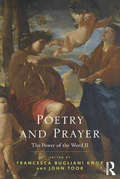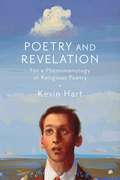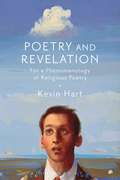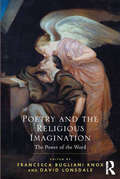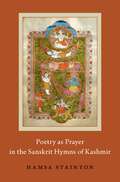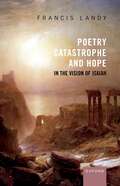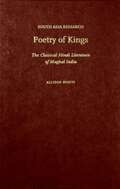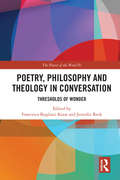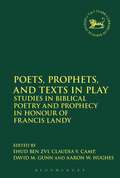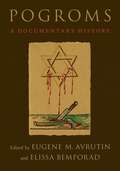- Table View
- List View
The Poetry and Music of Science: Comparing Creativity in Science and Art
by Tom McLeishWhat human qualities are needed to make scientific discoveries, and which to make great art? Many would point to 'imagination' and 'creativity' in the second case but not the first. This book challenges the assumption that doing science is in any sense less creative than art, music or fictional writing and poetry, and treads a historical and contemporary path through common territories of the creative process. The methodological process called the 'scientific method' tells us how to test ideas when we have had them, but not how to arrive at hypotheses in the first place. Hearing the stories that scientists and artists tell about their projects reveals commonalities: the desire for a goal, the experience of frustration and failure, the incubation of the problem, moments of sudden insight, and the experience of the beautiful or sublime. Selected themes weave the practice of science and art together: visual thinking and metaphor, the transcendence of music and mathematics, the contemporary rise of the English novel and experimental science, and the role of aesthetics and desire in the creative process. Artists and scientists make salient comparisons: Defoe and Boyle; Emmerson and Humboldt, Monet and Einstein, Schumann and Hadamard. The book draws on medieval philosophy at many points as the product of the last age that spent time in inner contemplation of the mystery of how something is mentally brought out from nothing. Taking the phenomenon of the rainbow as an example, the principles of creativity within constraint point to the scientific imagination as a parallel of poetry.
Poetry and Prayer: The Power of the Word II (The Power of the Word)
by Francesca Bugliani Knox John TookInterdisciplinary and ecumenical in scope, Poetry and Prayer offers theoretical discussion on the profound connection between poetic inspiration and prayer as well as reflection on the work of individual writers and the traditions within which they stand. An international range of established and new scholars in literary studies and theology offer unique contributions to the neglected study of poetry in relation to prayer. Part I addresses the relationship of prayer and poetry. Parts II and III consider these and related ideas from the point of view of their implementation in a range of different authors and traditions, offering case studies from, for example, the Bible, Dante, Shakespeare and Herbert, as well as twentieth-century poets such as Thomas Merton, Denise Levertov, W.H. Auden and R.S. Thomas.
Poetry and Prayer: The Power of the Word II (The Power of the Word)
by Francesca Bugliani Knox John TookInterdisciplinary and ecumenical in scope, Poetry and Prayer offers theoretical discussion on the profound connection between poetic inspiration and prayer as well as reflection on the work of individual writers and the traditions within which they stand. An international range of established and new scholars in literary studies and theology offer unique contributions to the neglected study of poetry in relation to prayer. Part I addresses the relationship of prayer and poetry. Parts II and III consider these and related ideas from the point of view of their implementation in a range of different authors and traditions, offering case studies from, for example, the Bible, Dante, Shakespeare and Herbert, as well as twentieth-century poets such as Thomas Merton, Denise Levertov, W.H. Auden and R.S. Thomas.
Poetry and Revelation: For a Phenomenology of Religious Poetry
by Kevin HartReligious poetry has often been regarded as minor poetry and dismissed in large part because poetry is taken to require direct experience; whereas religious poetry is taken to be based on faith, that is, on second or third hand experience. The best methods of thinking about "experience" are given to us by phenomenology. Poetry and Revelation is the first study of religious poetry through a phenomenological lens, one that works with the distinction between manifestation (in which everything is made manifest) and revelation (in which the mystery is re-veiled as well as revealed). Providing a phenomenological investigation of a wide range of “religious poems”, some medieval, some modern; some written in English, others written in European languages; some from America, some from Britain, and some from Australia, Kevin Hart provides a unique new way of thinking about religious poetry and the nature of revelation itself.
Poetry and Revelation: For a Phenomenology of Religious Poetry
by Kevin HartReligious poetry has often been regarded as minor poetry and dismissed in large part because poetry is taken to require direct experience; whereas religious poetry is taken to be based on faith, that is, on second or third hand experience. The best methods of thinking about "experience" are given to us by phenomenology. Poetry and Revelation is the first study of religious poetry through a phenomenological lens, one that works with the distinction between manifestation (in which everything is made manifest) and revelation (in which the mystery is re-veiled as well as revealed). Providing a phenomenological investigation of a wide range of “religious poems”, some medieval, some modern; some written in English, others written in European languages; some from America, some from Britain, and some from Australia, Kevin Hart provides a unique new way of thinking about religious poetry and the nature of revelation itself.
Poetry and the Religious Imagination: The Power of the Word (The Power of the Word)
by David Lonsdale Francesca Bugliani KnoxWhat is the role of spiritual experience in poetry? What are the marks of a religious imagination? How close can the secular and the religious be brought together? How do poetic imagination and religious beliefs interact? Exploring such questions through the concept of the religious imagination, this book integrates interdisciplinary research in the area of poetry on the one hand, and theology, philosophy and Christian spirituality on the other. Established theologians, philosophers, literary critics and creative writers explain, by way of contemporary and historical examples, the primary role of the religious imagination in the writing as well as in the reading of poetry.
Poetry and the Religious Imagination: The Power of the Word (The Power of the Word)
by David Lonsdale Francesca Bugliani KnoxWhat is the role of spiritual experience in poetry? What are the marks of a religious imagination? How close can the secular and the religious be brought together? How do poetic imagination and religious beliefs interact? Exploring such questions through the concept of the religious imagination, this book integrates interdisciplinary research in the area of poetry on the one hand, and theology, philosophy and Christian spirituality on the other. Established theologians, philosophers, literary critics and creative writers explain, by way of contemporary and historical examples, the primary role of the religious imagination in the writing as well as in the reading of poetry.
Poetry and Theology in the Modernist Period
by Anthony DomesticoFollowing the religious turn in other disciplines, literary critics have emphasized how modernists like Woolf and Joyce were haunted by Christianity;€™s cultural traces despite their own lack of belief. In Poetry and Theology in the Modernist Period, Anthony Domestico takes a different tack, arguing that modern poets such as T. S. Eliot, W. H. Auden, and David Jones were interested not just in the aesthetic or social implications of religious experience but also in the philosophically rigorous, dogmatic vision put forward by contemporary theology. These poets took seriously the truth claims of Christian theology: for them, religion involved intellectual and emotional assent, doctrinal articulation, and ritual practice. Domestico reveals how an important strand of modern poetry actually understood itself in and through the central theological questions of the modernist era: What is transcendence, and how can we think and write about it? What is the sacramental act, and how does its wedding of the immanent and the transcendent inform the poetic act? How can we relate kairos (holy time) to chronos (clock time)? Seeking answers to these complex questions, Domestico examines both modernist institutions (the Criterion) and specific works of modern poetry (Eliot;€™s Four Quartets and Jones;€™s The Anathemata). The book also traces the contours of what it dubs "theological modernism": a body of poetry that is both theological and modernist. In doing so, this book offers a new literary history of the modernist period, one that attends both to the material circulation of texts and to the broader intellectual currents of the time.
Poetry and Theology in the Modernist Period
by Anthony DomesticoFollowing the religious turn in other disciplines, literary critics have emphasized how modernists like Woolf and Joyce were haunted by Christianity;€™s cultural traces despite their own lack of belief. In Poetry and Theology in the Modernist Period, Anthony Domestico takes a different tack, arguing that modern poets such as T. S. Eliot, W. H. Auden, and David Jones were interested not just in the aesthetic or social implications of religious experience but also in the philosophically rigorous, dogmatic vision put forward by contemporary theology. These poets took seriously the truth claims of Christian theology: for them, religion involved intellectual and emotional assent, doctrinal articulation, and ritual practice. Domestico reveals how an important strand of modern poetry actually understood itself in and through the central theological questions of the modernist era: What is transcendence, and how can we think and write about it? What is the sacramental act, and how does its wedding of the immanent and the transcendent inform the poetic act? How can we relate kairos (holy time) to chronos (clock time)? Seeking answers to these complex questions, Domestico examines both modernist institutions (the Criterion) and specific works of modern poetry (Eliot;€™s Four Quartets and Jones;€™s The Anathemata). The book also traces the contours of what it dubs "theological modernism": a body of poetry that is both theological and modernist. In doing so, this book offers a new literary history of the modernist period, one that attends both to the material circulation of texts and to the broader intellectual currents of the time.
Poetry as Prayer in the Sanskrit Hymns of Kashmir (AAR Religion in Translation)
by Hamsa StaintonHistorically, Kashmir was one of the most dynamic and influential centers of Sanskrit learning and literary production in South Asia. In Poetry as Prayer in the Sanskrit Hymns of Kashmir, Hamsa Stainton investigates the close connection between poetry and prayer in South Asia by studying the history of Sanskrit hymns of praise (stotras) in Kashmir. The book provides a broad introduction to the history and general features of the stotra genre, and it charts the course of these literary hymns in Kashmir from the eighth century to the present. In particular, it offers the first major study in any European language of the Stutikusum=añjali, an important work of religious literature dedicated to the god 'Siva and one of the only extant witnesses to the trajectory of Sanskrit literary culture in fourteenth-century Kashmir. The book also contributes to the study of 'Saivism by examining the ways in which 'Saiva poets have integrated the traditions of Sanskrit literature and poetics, theology (especially non-dualism), and 'Saiva worship and devotion. It substantiates the diverse configurations of 'Saiva bhakti expressed and explored in these literary hymns and the challenges they present for standard interpretations of Hindu bhakti. More broadly, this study of stotras from Kashmir offers new perspectives on the history and vitality of prayer in South Asia and its complex relationships to poetry and poetics.
Poetry as Prayer in the Sanskrit Hymns of Kashmir (AAR Religion in Translation)
by Hamsa StaintonHistorically, Kashmir was one of the most dynamic and influential centers of Sanskrit learning and literary production in South Asia. In Poetry as Prayer in the Sanskrit Hymns of Kashmir, Hamsa Stainton investigates the close connection between poetry and prayer in South Asia by studying the history of Sanskrit hymns of praise (stotras) in Kashmir. The book provides a broad introduction to the history and general features of the stotra genre, and it charts the course of these literary hymns in Kashmir from the eighth century to the present. In particular, it offers the first major study in any European language of the Stutikusum=añjali, an important work of religious literature dedicated to the god 'Siva and one of the only extant witnesses to the trajectory of Sanskrit literary culture in fourteenth-century Kashmir. The book also contributes to the study of 'Saivism by examining the ways in which 'Saiva poets have integrated the traditions of Sanskrit literature and poetics, theology (especially non-dualism), and 'Saiva worship and devotion. It substantiates the diverse configurations of 'Saiva bhakti expressed and explored in these literary hymns and the challenges they present for standard interpretations of Hindu bhakti. More broadly, this study of stotras from Kashmir offers new perspectives on the history and vitality of prayer in South Asia and its complex relationships to poetry and poetics.
Poetry, Catastrophe, and Hope in the Vision of Isaiah
by Prof Francis LandyThe book of Isaiah is one of the longest and strangest books of the Hebrew Bible, composed over several centuries and traversing the catastrophe that befell the two kingdoms of Israel and Judah in the 8th and 6th centuries BCE. Francis Landy's book tells the story of the poetic response to catastrophe, and the hope for a new and perfect world on the other side. The study traces two parallel developments: the displacement of the Davidic promise onto the Persian Empire, Israel, and the prophet himself; and the transition from exclusively male images of the deity to the matching of male and female prototypes, whereby YHWH takes the place of the warrior goddess. Utopia, Catastrophe, and Poetry in the Book of Isaiah consists of close readings of individual passages in Isaiah, commencing with Chapter One and the problems of beginning, and ending with Deutero-Isaiah, composed subsequent to the Babylonian exile. The volume is arranged thematically as well as sequentially: the first chapter following the introduction concerns gender, the second death, the third the Oracles about the Nations. At the centre there is what Landy calls 'the constitutive enigma', Isaiah's commission in his vision to speak so that people will not understand. This renders the entire book potentially incomprehensible; the more we try to understand it, the greater the difficulty. For Landy, this creates a model of reading and writing, the challenge and the risk of going up blind alleys, of trying to make sense of a disastrous world. Isaiah's commission pervades the book. Throughout there is a promise of an age of clarity as well as social and political transformation, which is always deferred beyond the horizon. Hence it is a book without an ending, or with multiple endings. In the final chapters, the author turns to the central Chapter Thirty-Three, a mise-en-abyme of the book and a prayer for deliverance, and the issues of exile and the possibility of return. Like every poetic work, particularly in an era of cultural collapse, it is a critique of the past and a hope for a new humanity.
Poetry, Catastrophe, and Hope in the Vision of Isaiah
by Prof Francis LandyThe book of Isaiah is one of the longest and strangest books of the Hebrew Bible, composed over several centuries and traversing the catastrophe that befell the two kingdoms of Israel and Judah in the 8th and 6th centuries BCE. Francis Landy's book tells the story of the poetic response to catastrophe, and the hope for a new and perfect world on the other side. The study traces two parallel developments: the displacement of the Davidic promise onto the Persian Empire, Israel, and the prophet himself; and the transition from exclusively male images of the deity to the matching of male and female prototypes, whereby YHWH takes the place of the warrior goddess. Utopia, Catastrophe, and Poetry in the Book of Isaiah consists of close readings of individual passages in Isaiah, commencing with Chapter One and the problems of beginning, and ending with Deutero-Isaiah, composed subsequent to the Babylonian exile. The volume is arranged thematically as well as sequentially: the first chapter following the introduction concerns gender, the second death, the third the Oracles about the Nations. At the centre there is what Landy calls 'the constitutive enigma', Isaiah's commission in his vision to speak so that people will not understand. This renders the entire book potentially incomprehensible; the more we try to understand it, the greater the difficulty. For Landy, this creates a model of reading and writing, the challenge and the risk of going up blind alleys, of trying to make sense of a disastrous world. Isaiah's commission pervades the book. Throughout there is a promise of an age of clarity as well as social and political transformation, which is always deferred beyond the horizon. Hence it is a book without an ending, or with multiple endings. In the final chapters, the author turns to the central Chapter Thirty-Three, a mise-en-abyme of the book and a prayer for deliverance, and the issues of exile and the possibility of return. Like every poetic work, particularly in an era of cultural collapse, it is a critique of the past and a hope for a new humanity.
Poetry of Kings: The Classical Hindi Literature of Mughal India (South Asia Research)
by Allison BuschThis in-depth study of the classical Hindi tradition brings the world of Mughal-era poetry and court culture alive for an English readership. Allison Busch draws on the perspectives of literary, social, and intellectual history to elucidate one of premodern India's most significant textual traditions, documenting the dramatic rise of a new type of professional Hindi writer while providing critical insight into the motives that animated this literary community and its patrons. Busch examines how riti literature served as an important aesthetic and political resource in the richly multicultural world of Mughal India, and provides, for the first time in a Western language, a detailed study of the fascinating oeuvre of Keshavdas, whose seminal Rasikpriya (Handbook for poetry connoisseurs, 1591) was the catalyst for a new Hindi classicism that attracted a spectacular following in the leading courts of early modern India. The circulation of Hindi literature among diverse communities during this period is testament to a remarkable pluralism that cannot be understood in terms of the nationalist logic that has constrained modern Hindi and Urdu to be "Hindu" and "Muslim" languages since the nineteenth century. With the cultural reforms ushered in by colonialism, north Indians repudiated the classical traditions of the courtly past, a complex process given extended treatment in the final chapter. Busch provides valuable insight into more than two centuries of Hindi courtly culture. Poetry of Kings also showcases the importance of bringing precolonial archives into dialogue with current debates of postcolonial theory.
Poetry, Philosophy and Theology in Conversation: Thresholds of Wonder: The Power of the Word IV
by Francesca Bugliani Knox Jennifer ReekThis volume is a collection of essays that explains how literature, philosophy and theology have explored the role of wonder in our lives, particularly through poetry. Wonder has been an object of fascination for these disciplines from the Greek antiquity onwards, yet the connections between their views on the subject are often ignored in subject specific studies. The book is divided into three parts: Part I opens the conversation on wonder in philosophy, Part II is given to theology and Part III to literary perspectives. An international set of contributors, including poets as well as scholars, have produced a study that looks beyond traditional chronological, geographical and disciplinary boundaries, both within the individual essays themselves and in respect to one another. The volume’s wide historical framework is punctuated by four poems by contemporary poets on the theme of wonder. An unconventional foray into one of the best-known themes of the European tradition, this book will be of great interest to scholars of literature, theology and philosophy.
Poetry, Philosophy and Theology in Conversation: Thresholds of Wonder: The Power of the Word IV
by Francesca Bugliani Knox Jennifer ReekThis volume is a collection of essays that explains how literature, philosophy and theology have explored the role of wonder in our lives, particularly through poetry. Wonder has been an object of fascination for these disciplines from the Greek antiquity onwards, yet the connections between their views on the subject are often ignored in subject specific studies. The book is divided into three parts: Part I opens the conversation on wonder in philosophy, Part II is given to theology and Part III to literary perspectives. An international set of contributors, including poets as well as scholars, have produced a study that looks beyond traditional chronological, geographical and disciplinary boundaries, both within the individual essays themselves and in respect to one another. The volume’s wide historical framework is punctuated by four poems by contemporary poets on the theme of wonder. An unconventional foray into one of the best-known themes of the European tradition, this book will be of great interest to scholars of literature, theology and philosophy.
Poetry, Practical Theology and Reflective Practice (Explorations in Practical, Pastoral and Empirical Theology)
by Mark PryceThis groundbreaking study offers an innovative critical analysis of poetry as a resource for reflective practice in the context of continuing professional development. In the contemporary drive in all professions for greater rigour in education, training, and development, little attention is paid to the inner shape of learning and meaning-making for individuals and groups, especially ways in which individuals are formed for the task of their work. Building on empirical research into the author’s professional practice, the book takes the use of poetry in clergy continuing ministerial development as a case-study to examine the value of poetry in professional learning. Setting out the advantages and limitations of poetry as a stimulant for imaginative, critical reflexivity, and formation within professional reflective practice, the study develops a practical model for group reflection around poetry, distilling pedagogical approaches for working effectively with poetry in continuing professional development. Drawing together a number of strands of thinking about poetry, Practical Theology, and reflective practice into a tightly argued study, the book is an important methodological resource. It makes available a range of primary and secondary sources, offering researchers into professional practice a model of ethnographic research in Practical Theology which embraces innovative methods for reflexivity and theological reflection, including the value of auto-ethnographic poetry.
Poetry, Practical Theology and Reflective Practice (Explorations in Practical, Pastoral and Empirical Theology)
by Mark PryceThis groundbreaking study offers an innovative critical analysis of poetry as a resource for reflective practice in the context of continuing professional development. In the contemporary drive in all professions for greater rigour in education, training, and development, little attention is paid to the inner shape of learning and meaning-making for individuals and groups, especially ways in which individuals are formed for the task of their work. Building on empirical research into the author’s professional practice, the book takes the use of poetry in clergy continuing ministerial development as a case-study to examine the value of poetry in professional learning. Setting out the advantages and limitations of poetry as a stimulant for imaginative, critical reflexivity, and formation within professional reflective practice, the study develops a practical model for group reflection around poetry, distilling pedagogical approaches for working effectively with poetry in continuing professional development. Drawing together a number of strands of thinking about poetry, Practical Theology, and reflective practice into a tightly argued study, the book is an important methodological resource. It makes available a range of primary and secondary sources, offering researchers into professional practice a model of ethnographic research in Practical Theology which embraces innovative methods for reflexivity and theological reflection, including the value of auto-ethnographic poetry.
Poets, Prophets, and Texts in Play: Studies in Biblical Poetry and Prophecy in Honour of Francis Landy (The Library of Hebrew Bible/Old Testament Studies #597)
by Ehud Ben Zvi Claudia V. Camp David M. Gunn Aaron W. HughesIn this volume, a list of esteemed scholars engage with the literary readings of prophetic and poetic texts in the Hebrew Bible that revolve around sensitivity to the complexity of language, the fragility of meaning, and the interplay of texts. These themes are discussed using a variety of hermeneutical strategies. In Part 1, Poets and Poetry, some essays address the nature of poetic language itself, while others play with themes of love, beauty, and nature in specific poetic texts. The essays in Part 2, Prophets and Prophecy, consider prophets and prophecy from a number of interpretive directions, moving from internal literary analysis to the reception of these texts and their imagery in a range of ancient and modern contexts. Those in Part 3, on the other hand, Texts in Play, take more recent works (from Shakespeare to Tove Jansson's Moomin books for children) as their point of departure, developing conversations between texts across the centuries that enrich the readings of both the ancient and modern pieces of literature.
Pogroms: A Documentary History
by Eugene M. Avrutin, Elissa BemporadFrom the 1880s to the 1940s, an upsurge of explosive pogroms caused much pain and suffering across the eastern borderlands of Europe. Rioters attacked Jewish property and caused physical harm to women and children. During World War I and the Russian Civil War, pogrom violence turned into full-blown military actions. In some cases, pogroms wiped out of existence entire Jewish communities. More generally, they were part of a larger story of destruction, ethnic purification, and coexistence that played out in the region over a span of some six decades. Pogroms: A Documentary History surveys the complex history of anti-Jewish violence by bringing together archival and published sources--many appearing for the first time in English translation. The documents assembled here include eyewitness testimony, oral histories, diary excerpts, literary works, trial records, and press coverage. They also include memos and field reports authored by army officials, investigative commissions, humanitarian organizations, and government officials. This landmark volume and its distinguished roster of scholars provides an unprecedented view of the history of pogroms.
Pogroms: A Documentary History
From the 1880s to the 1940s, an upsurge of explosive pogroms caused much pain and suffering across the eastern borderlands of Europe. Rioters attacked Jewish property and caused physical harm to women and children. During World War I and the Russian Civil War, pogrom violence turned into full-blown military actions. In some cases, pogroms wiped out of existence entire Jewish communities. More generally, they were part of a larger story of destruction, ethnic purification, and coexistence that played out in the region over a span of some six decades. Pogroms: A Documentary History surveys the complex history of anti-Jewish violence by bringing together archival and published sources--many appearing for the first time in English translation. The documents assembled here include eyewitness testimony, oral histories, diary excerpts, literary works, trial records, and press coverage. They also include memos and field reports authored by army officials, investigative commissions, humanitarian organizations, and government officials. This landmark volume and its distinguished roster of scholars provides an unprecedented view of the history of pogroms.
Pointing at the Moon: Buddhism, Logic, Analytic Philosophy
by Jay L. Garfield Tom J.F. Tillemans Mario D'AmatoThis volume collects essays by philosophers and scholars working at the interface of Western philosophy and Buddhist Studies. Many have distinguished scholarly records in Western philosophy, with expertise in analytic philosophy and logic, as well as deep interest in Buddhist philosophy. Others have distinguished scholarly records in Buddhist Studies with strong interests in analytic philosophy and logic. All are committed to the enterprise of cross-cultural philosophy and to bringing the insights and techniques of each tradition to bear in order to illuminate problems and ideas of the other. These essays address a broad range of topics in the philosophy of mind, philosophy of language, logic, epistemology, and metaphysics, and demonstrate the fecundity of the interaction between the Buddhist and Western philosophical and logical traditions.
Pointless: The Reality behind Quantum Theory
by RW BoyerThis book examines how major interpretations of quantum theory are progressing toward a more unified understanding and experience of nature. It offers subtle insights to address core issues of wave-particle duality, the measurement problem, the mind/body problem, determinism/indeterminism/free will, and the nature of consciousness. It draws from physics, consciousness studies, and ‘ancient Vedic science’ to outline a new holistic interpretation of quantum theory. Accessible and thought-provoking, it will be profoundly integrating for scholars and researchers in science and technology, in philosophy, and also in South Asian studies.
Pointless: The Reality behind Quantum Theory
by RW BoyerThis book examines how major interpretations of quantum theory are progressing toward a more unified understanding and experience of nature. It offers subtle insights to address core issues of wave-particle duality, the measurement problem, the mind/body problem, determinism/indeterminism/free will, and the nature of consciousness. It draws from physics, consciousness studies, and ‘ancient Vedic science’ to outline a new holistic interpretation of quantum theory. Accessible and thought-provoking, it will be profoundly integrating for scholars and researchers in science and technology, in philosophy, and also in South Asian studies.

